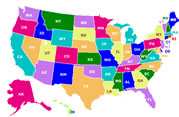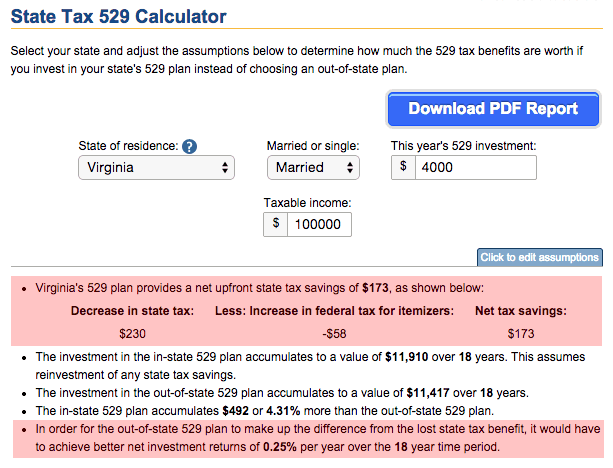 I’m getting ready to put down a decent chunk of money into a 529 college savings plan, which means lots of research as there are a lot of options and nuances. A general plan for those without strong investment preferences would be to go with one of the age-based portfolios from a consistently top-rated plan by Morningstar, or your in-state plan if the tax deduction is juicy enough.
I’m getting ready to put down a decent chunk of money into a 529 college savings plan, which means lots of research as there are a lot of options and nuances. A general plan for those without strong investment preferences would be to go with one of the age-based portfolios from a consistently top-rated plan by Morningstar, or your in-state plan if the tax deduction is juicy enough.
But how exactly do you compare them? The easiest way to calculate your in-state tax benefits is to use a tool from either Vanguard or SavingforCollege.com.
Let’s say you are a married Virginia resident making $100,000 in household taxable income and you want to contribution $4,000 a year to college. Here’s what the Vanguard tool says:

The big block of text explains the assumptions the tool had to make in order to keep things simple. Note that in addition to the state tax savings, you have to consider that you’ll have less state tax to deduct on your federal return (if you itemize deductions).
The SavingForCollege tool comes to the same conclusion regarding tax savings (minus a rounding difference). However, it also goes one step further and helps you quantify the relative value of your in-state tax deduction.

In order for the out-of-state 529 plan to make up the difference from the lost state tax benefit, it would have to achieve better net investment returns of 0.25% per year over the 18 year time period.
So if your in-state plan offers similar desired investments but with expense ratios that were 0.25% higher than the best out-of-state plan, you may actually want to forgo the tax deduction. Note that this number is also based on a set of default assumptions like an 18-year investment period and a 6% annual returns for both plans (you can edit these as you like).
But wait! Some state plans allow you to roll your assets over to another state after making the contribution, and keep the tax deduction. So you could make the contribution, grab the tax credit, and then roll it over into another state’s plan. (You are allowed to have multiple 529 plans.) However, many states have a recapture or “clawback” provision that will make you pay back the tax benefit somehow. For example, if you perform a rollover or non-qualified withdrawal from the Virginia 529 plan, the principal portion will be added back to your Virginia taxable income (to the extent of any prior deductions).
 The Best Credit Card Bonus Offers – 2025
The Best Credit Card Bonus Offers – 2025 Big List of Free Stocks from Brokerage Apps
Big List of Free Stocks from Brokerage Apps Best Interest Rates on Cash - 2025
Best Interest Rates on Cash - 2025 Free Credit Scores x 3 + Free Credit Monitoring
Free Credit Scores x 3 + Free Credit Monitoring Best No Fee 0% APR Balance Transfer Offers
Best No Fee 0% APR Balance Transfer Offers Little-Known Cellular Data Plans That Can Save Big Money
Little-Known Cellular Data Plans That Can Save Big Money How To Haggle Your Cable or Direct TV Bill
How To Haggle Your Cable or Direct TV Bill Big List of Free Consumer Data Reports (Credit, Rent, Work)
Big List of Free Consumer Data Reports (Credit, Rent, Work)
Hi Jonathan,
It would be great if you can tell us where you have 529 accounts.
I have in Ohio and planning to open in Vanguard but I belive the charge some yearly fees. Not sue though. Ohio does not charge any fees so went with that.
This is an extremely useful explanation and very good points to consider. Thank you for posting it!
For those running these analyses, double-check your state marginal tax rate under “edit assumptions.” Mine had the correct top-line state tax rate for my income, but I also have local/county income taxes at an additional 2+% that are collected by the state, and that higher all-in rate was not reflected by just using the state rate only. YMMV.
I live in WA, which doesn’t have state taxes. Hence, WA offers a GET plan (guaranteed future tuition). Any recommendations/comparisons of such a plan with the traditional 529 state plan that offers tax benefits?
According to one of my friends, he instead invests in ROTH-IRA, then he does not have to use it just for education in case things change in future. Have you considered ROTH-IRA instead of 529 plan? Any thoughts would be appreciated.
Can’t see the big advantage of a Roth IRA over 529. Given some income levels getting cash into a roth ira you must do the whole convert thing so right after investing you better convert or you pay taxes. Instead with the 529 we just drop in x amount per kid per per month. So just better investing options? Lower fees? Looks like Vanguard is lower on fees for 529 than an IRA.
If one kid doesn’t go we can always roll the 529 under the second kid. Or just cash it out and pay the taxes. It would be pretty much impossible to believe the kids won’t go to college as both sides of the family that’s pretty much unheard of… what is more likely is our goal of 250k per kid will come up short on enough funds to last through undergrad.
It seems like the tide is shifting from a 529 to a Roth IRA. On the bogleheads forum, a recent discussion was in favor of ROTH. The main thing seems to be flexibility and how retirement is not considered part of one’s application for financial aid (529 plans are). Perhaps time to do another blog post?
Our state allows a state tax deduction regardless of which state’s 529 plan is used! I researched them all (many years ago) and selected Utah’s. My first kid is in the college now, and I’ve been pleased with my choice.
I live in CA, and receive no state tax benefits from any 529 plans, including CA state’s own 529 plan!
So, I chose Utah State’s 529 plan. While it is not the lowest fee plan, I found this plan to have the best fund selection and age-based glidepath that met my needs. The fund’s age-based aggressive portfolio has two options: Domestic & International. While both these hold a 100% in equity until the child turns 7 (and then slowly glide towards 100% money market by the time the child is college age), the International portfolio holds 30% of the equities in International and 70% in domestic. This met my needs quite well, so I decided to go with Utah State.
I live in CA, married with no kids , but am already planning for hypothetical kid’s college fund (what can I say, I like to study my investments). I’m not entirely sold on 529 but also realize that funding my hypothetical kid’s college with taxable account may not be the best way to go (CA also taxes capital gains as income). Then there is the “kiddie tax” if there were a taxable account in hypothetical kid’s name. I’d have the hypothetical kid fund her/his own roth IRA if I could figure out how to get babies to have earned income! Maybe future kid can be a baby model or something LOL.